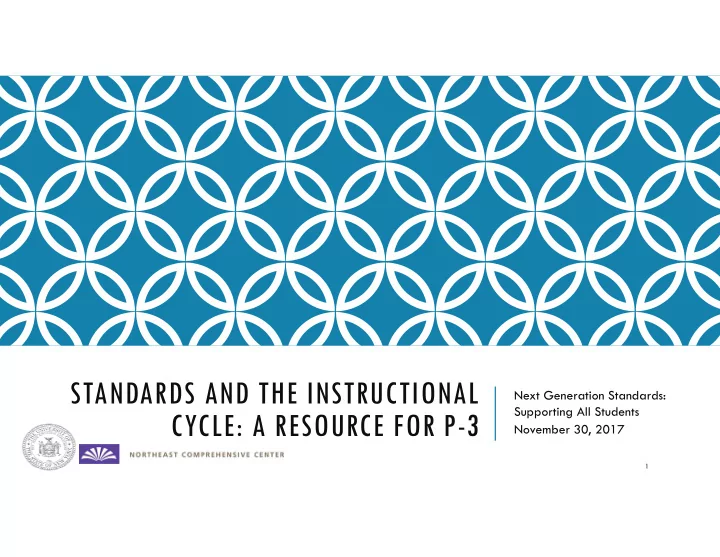

STANDARDS AND THE INSTRUCTIONAL Next Generation Standards: Supporting All Students CYCLE: A RESOURCE FOR P-3 November 30, 2017 1
WELCOME AND INTRODUCTIONS � Meg McNiff Lynnette Pannucci Office of Early Office of Early Learning Learning Sarah Hughes Northeast Comprehensive Center 2
GOAL FOR TODAY AND AGENDA OVERVIEW Goal: Increase understanding about the relationships and distinctions between standards, curriculum, instruction and assessment Agenda: Introduce the resource and provide a brief history of the development Engage in discussions about standards implementation Work through a process for planning discussions about P-3 3
BACKGROUND: WHY A RESOURCE ABOUT STANDARDS AND THE INSTRUCTIONAL CYCLE? • ELA Subgroup Raised concerns about appropriateness, Standards Review compatibility, alignment, expectations, instruction, Process assessment, whole child, DAP • Met three times to focus on issues raised; provided P2 Early Learning guidance for introductory materials, conducted review; Standards Task Force provided recommendations on wording, next steps BOR Blue Ribbon • Check back soon! Committee 4
GETTING ON THE SAME PAGE: STANDARDS, � CURRICULUM, INSTRUCTION, ASSESSMENT � I don’t I t know! ! See e you u there! ! 5
STARTING PLACE: TERMINOLOGY � Key Elements Select Terminology or Concepts Related to Key Elements Direct/explicit STANDARDS Analyze Group Observe Activity instruction Intervention Teach Adjust Content Plan Connection CURRICULUM Evidence- Play Outcomes Individualize Responsive based INSTRUCTION Scaffold Reflect Testing Model Integrate Child- Learning Feedback Differentiate Interact centered center ASSESSMENT Coach Goals Re-teach Design Screen 6
HOW IT WAS DEVELOPED 7
STUDENTS AT THE CENTER � Teams put students in the center of the design. This signifies many things, The double arrows between student including: learning and the three elements remind us that students are active participants and at ‹ All students the core of the instructional process. Understanding who students are, what they ‹ Whole students know and are able to do are essential to providing instruction that is individualized, ‹ Diverse students differentiated, culturally and linguistically relevant, and context-based. � 8
A structure for discussing the relationships and distinctions among learning standards, curriculum, instruction, and assessment within the context of prekindergarten – 3 rd grade ‹ Cyclical nature ‹ Process of reflect, inform, adjust ‹ Individualized, differentiated, culturally and linguistically relevant, context-based ‹ Aligned and coherent 9
STANDARDS Student learning goals defined by subjects, grades, and in some cases, by grade bands; the “Where are we going” or destination ∑ Articulate a learning progression along a continuum ∑ Provide a framework for local planning and development ∑ PK standards address ALL domains. Approaches to Learning , Physical Development and Health, Social and Emotional Development , Communication Language and Literacy, Cognition and Knowledge of the World ∑ NOT designed as a lockstep progression of lessons or curricula since children’s pace of development is not uniform 10
CURRICULUM Content, concepts, and skills that provide a roadmap for what is taught; the “what” ∑ Flexible design to meet unique needs of students ∑ Cultural and linguistic contexts ∑ Follow developmental sequence within content areas ∑ Emphasize robust , interactive , and integrated learning experiences ∑ Address ALL domains of learning and development since they are intrinsically linked and mutually supportive 11
INSTRUCTION Approaches and strategies used to teach content so students can learn; the “how” ∑ Act of teaching to meet students where they are; outlined by curricula and guided by what is understood about individual students ∑ Utilizes learning environments, interacting with students/connection, creating a classroom culture, fostering student engagement, embedding social/emotional supports ∑ Hands-on practice and purposeful * PLAY* are vital instructional strategies for students to understand abstract concepts, hone skills, and for teachers to observe student learning and social interaction ∑ Grounded in child development theory and DAP ∑ Ongoing, cyclical and intrinsically linked to formal and informal assessment 12
ASSESSMENT Multiple, varied processes used to understand more about student learning and development and to guide and inform teaching, the “where are we now” and “where should we go next” ∑ Screening and diagnostic: is there a need and what is that need ∑ Formative: ongoing methods to inform instruction and individualize goals and learning experiences ∑ Observation, work samples, interaction to analyze student understanding and progression ∑ Used to modify instruction, refine environment, provide feedback, connect with families ∑ Summative: report about acquisition of knowledge and skills at end of prescribed term often to evaluate effectiveness (not typically used P-3) 13
TABLE ACTIVITY • Read through the 5 scenarios individually Step 1 • Discuss the scenarios as a table group using guiding questions (Which element does this relate to most? Is this based on a state or local Step 2 decision/assumption? How would you address the challenge?) • Report out on 1 scenario that the group found most interesting � • What state-level supports would be helpful? (e.g., guidance, Step 3 examples, definitions, networking) 14
WRAP UP AND THANK YOU! WAIT! Before you go, please complete the SHORT evaluation form on your table. THANK YOU! 15
Recommend
More recommend